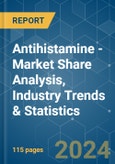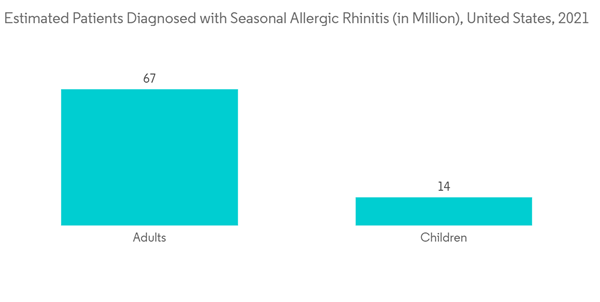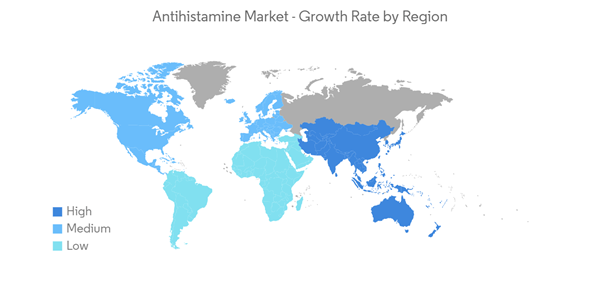The antihistamine market is expected to register a CAGR of 7.7% over the forecast period.
COVID-19 has significantly impacted the antihistamines market as many clinical trials and in vitro, studies have shown several antihistamines to be promising in the management of Covid19 by easing pulmonary symptoms. For instance, according to a study published in Health Science Reports in February 2023, antihistamines specific to Covid-19 have to be identified and added as a fundamental treatment method to the care plan for Covid-19, along with other techniques. They appear to be effective in treating Covid-19 while removing symptoms quickly and giving the body enough time to reset its defense mechanisms, resulting in a speedy recovery. The market has seen a slight decline during the early pandemic, due to supply chain restrictions and manufacturing halts. However, during the late pandemic, the market has attained a significant pace due to the inclusion of antihistamines in COVID-19 treatment protocols. Furthermore, the market has seen lucrative growth post-pandemic and is anticipated to show the same trend over the forecast period.
The factors driving the market growth include rising issues of allergies and stomach disorders, rising in the research and development activities for the development of novel dosage forms.
The rising issues of allergies and acid reflex are anticipated to drive the growth of the market studied over the forecast period. For instance, according to the Asthma and Allergy Foundation 2023, approximately 81 million people in the United States in 2021 were diagnosed with seasonal allergic rhinitis (hay fever) including around 26% (67 million) of adults and 19% (14 million) of children. In addition, according to the study published in Rawal Medical Journal in September 2022, the prevalence of gastroesophageal reflex disease (GERD) was found to be 18.1 to 27.8% in NorthAmerica, 8.8 to 25.9% in Europe, 2.5 to 7.8% in East Asia, 8.7 to 33.1% in MiddleEast, 11.6% in Australia and 23% in South-America. Therefore, such a huge prevalence of allergies and stomach disorders is anticipated to increase the demand for antihistamines, driving the market growth.
Furthermore, rising advancements in development of novel dosage forms of antihistamine medications and approvals from the international regulatory agencies are anticipated to bolster the market growth over the forecast period. For instance, in June 2021, The United States Food and Drug Administration approved a nasal antihistamine (Azelastine HCI .15%) developed by Bayer through a procedure known as a partial prescription to nonprescription transition for seasonal and perennial allergic rhinitis. Therefore, the approvals of antihistamines as a nonprescription medication is anticipated to increase the adoption among people, driving the market growth.
Moreover, the price control and reimbursement of antihistamine drugs are anticipated to propel the market growth further. For intance, in November 2021, Taiho Pharmaceutical Co., Ltd. and Meiji Seika Pharma Co., Ltd's Bilanoa OD Tablets 20 mg (generic name: bilastine), an oral anti-allergy drug, in Japan has been listed on National Health Insurance reimbursement price list. The listing of drugs on reimbursement price list is anticipated to rise the adoption due to reduction in prices of antihistamine drugs, thereby driving the market growth.
Therefore, the rising issues of allergies and stomach disorders, favourable reimbursement policies and rising approvals from regulatory agencies are the factors anticipated to drive the market growth. However, the patent expiry of branded drugs, introduction of generic drugs and adverse affects associated with antihistamine drugs are impeding the market growth.
The rising initiatives from the key market players such as the launch of allergic antihistamine products are anticipated to drive the segment growth. For instance, in February 2021, Bausch + Lomb launched Alaway Preservative Free (ketotifen fumarate ophthalmic solution 0.035%) antihistamine eye drops in the United States. It is the over-the-counter (OTC) preservative-free antihistamine eye itch relief drop approved by the United States Food and Drug Administration. Therefore, the launch of OTC antihistamine drugs for allergies will lead to increase adoption driving the segment growth.
Furthermore, the efficacy of antihistamines in the treatment of allergies is anticipated to drive the segment growth further. For instance, according to the study published in the Brazilian Journal of Otorhinolaryngology in June 2023, oral H1 antihistamines are the first-line therapy for patients with allergic rhinitis, and rupatadine, an antihistamine is the most effective in alleviating symptoms of patients with allergic rhinitis. Therefore, the importance of antihistamine drugs in treating allergies will raise the demand for the segment studied, thereby propelling its growth.
Therefore, the rising initiatives from the key market players along with the high importance of antihistaminic drugs in treating allergies are the factors anticipated to show lucrative growth in this segment.
The rising prevalence of allergies is anticipated to drive the growth of the antihistamine market in the region. For instance, according to the Centers for Disease Control and Prevention (CDC) in January 2023, in the United States, 6.2% of individuals had food allergies, 7.3% had eczema, and 25.7% of adults had seasonal allergies in 2021. Furthermore, according to the Government of Canada in August 2021, allergic rhinitis affects 17% of adults in Quebec. Such a huge prevalence of allergies in the region is anticipated to increase the demand for antihistamines for the treatment of allergies, driving market growth.
In addition, the rising initiatives from the key market players and approvals of antihistamine medications by the national governments in the region are anticipated to boost market growth. For instance, in September 2022, Health Canada approved Ryaltris (olopatadine hydrochloride and mometasone furoate nasal spray) manufactured by Glenmark Pharmaceuticals subsidiary Glenmark Specialty's as a symptomatic therapy for moderate to severe seasonal allergic rhinitis (SAR).
Furthermore, the high funding for the research and development of allergic therapies is anticipated to propel the market growth. For instance, the National Institute of Health of United States has granted a funding of USD 6 million for allergic rhinitis (Hay Fever) and USD 77 million for food allergies for the development of drug therapies. This will lead to increased research and development and approvals of antihistamines, thereby anticipated to drive the market growth over the forecast period.
Therefore, the above factors such as rising allergic condition, rising initiatives from the key market players, among others are anticipated to drive the growth of the market studied in the region.
This product will be delivered within 2 business days.
COVID-19 has significantly impacted the antihistamines market as many clinical trials and in vitro, studies have shown several antihistamines to be promising in the management of Covid19 by easing pulmonary symptoms. For instance, according to a study published in Health Science Reports in February 2023, antihistamines specific to Covid-19 have to be identified and added as a fundamental treatment method to the care plan for Covid-19, along with other techniques. They appear to be effective in treating Covid-19 while removing symptoms quickly and giving the body enough time to reset its defense mechanisms, resulting in a speedy recovery. The market has seen a slight decline during the early pandemic, due to supply chain restrictions and manufacturing halts. However, during the late pandemic, the market has attained a significant pace due to the inclusion of antihistamines in COVID-19 treatment protocols. Furthermore, the market has seen lucrative growth post-pandemic and is anticipated to show the same trend over the forecast period.
The factors driving the market growth include rising issues of allergies and stomach disorders, rising in the research and development activities for the development of novel dosage forms.
The rising issues of allergies and acid reflex are anticipated to drive the growth of the market studied over the forecast period. For instance, according to the Asthma and Allergy Foundation 2023, approximately 81 million people in the United States in 2021 were diagnosed with seasonal allergic rhinitis (hay fever) including around 26% (67 million) of adults and 19% (14 million) of children. In addition, according to the study published in Rawal Medical Journal in September 2022, the prevalence of gastroesophageal reflex disease (GERD) was found to be 18.1 to 27.8% in NorthAmerica, 8.8 to 25.9% in Europe, 2.5 to 7.8% in East Asia, 8.7 to 33.1% in MiddleEast, 11.6% in Australia and 23% in South-America. Therefore, such a huge prevalence of allergies and stomach disorders is anticipated to increase the demand for antihistamines, driving the market growth.
Furthermore, rising advancements in development of novel dosage forms of antihistamine medications and approvals from the international regulatory agencies are anticipated to bolster the market growth over the forecast period. For instance, in June 2021, The United States Food and Drug Administration approved a nasal antihistamine (Azelastine HCI .15%) developed by Bayer through a procedure known as a partial prescription to nonprescription transition for seasonal and perennial allergic rhinitis. Therefore, the approvals of antihistamines as a nonprescription medication is anticipated to increase the adoption among people, driving the market growth.
Moreover, the price control and reimbursement of antihistamine drugs are anticipated to propel the market growth further. For intance, in November 2021, Taiho Pharmaceutical Co., Ltd. and Meiji Seika Pharma Co., Ltd's Bilanoa OD Tablets 20 mg (generic name: bilastine), an oral anti-allergy drug, in Japan has been listed on National Health Insurance reimbursement price list. The listing of drugs on reimbursement price list is anticipated to rise the adoption due to reduction in prices of antihistamine drugs, thereby driving the market growth.
Therefore, the rising issues of allergies and stomach disorders, favourable reimbursement policies and rising approvals from regulatory agencies are the factors anticipated to drive the market growth. However, the patent expiry of branded drugs, introduction of generic drugs and adverse affects associated with antihistamine drugs are impeding the market growth.
Antihistamine Market Trends
Allergic Disorders in Anticipated to Hold a Significant Share in the Market Studied
The allergic disorders segment is anticipated to hold a significant share of the market due to the rising adoption of antihistaminics in allergic conditions. In people with allergies, the body interprets allergens such as pollen, pet hair, or household dust as a threat and releases histamine. Histamine triggers an allergic reaction that manifests as itchy, watery eyes, runny or stuffy nose, sneezing, and skin rashes.The rising initiatives from the key market players such as the launch of allergic antihistamine products are anticipated to drive the segment growth. For instance, in February 2021, Bausch + Lomb launched Alaway Preservative Free (ketotifen fumarate ophthalmic solution 0.035%) antihistamine eye drops in the United States. It is the over-the-counter (OTC) preservative-free antihistamine eye itch relief drop approved by the United States Food and Drug Administration. Therefore, the launch of OTC antihistamine drugs for allergies will lead to increase adoption driving the segment growth.
Furthermore, the efficacy of antihistamines in the treatment of allergies is anticipated to drive the segment growth further. For instance, according to the study published in the Brazilian Journal of Otorhinolaryngology in June 2023, oral H1 antihistamines are the first-line therapy for patients with allergic rhinitis, and rupatadine, an antihistamine is the most effective in alleviating symptoms of patients with allergic rhinitis. Therefore, the importance of antihistamine drugs in treating allergies will raise the demand for the segment studied, thereby propelling its growth.
Therefore, the rising initiatives from the key market players along with the high importance of antihistaminic drugs in treating allergies are the factors anticipated to show lucrative growth in this segment.
North America is Expected to Hold a Significant Share in the Market Over the Forecast Period
North America is anticipated to hold a significant share of the market studied due to the rising incidence of allergies, the strong foothold of key market players, improved healthcare infrastructure, medicare policies, and funding from the government on research and development of allergic disorders, among others.The rising prevalence of allergies is anticipated to drive the growth of the antihistamine market in the region. For instance, according to the Centers for Disease Control and Prevention (CDC) in January 2023, in the United States, 6.2% of individuals had food allergies, 7.3% had eczema, and 25.7% of adults had seasonal allergies in 2021. Furthermore, according to the Government of Canada in August 2021, allergic rhinitis affects 17% of adults in Quebec. Such a huge prevalence of allergies in the region is anticipated to increase the demand for antihistamines for the treatment of allergies, driving market growth.
In addition, the rising initiatives from the key market players and approvals of antihistamine medications by the national governments in the region are anticipated to boost market growth. For instance, in September 2022, Health Canada approved Ryaltris (olopatadine hydrochloride and mometasone furoate nasal spray) manufactured by Glenmark Pharmaceuticals subsidiary Glenmark Specialty's as a symptomatic therapy for moderate to severe seasonal allergic rhinitis (SAR).
Furthermore, the high funding for the research and development of allergic therapies is anticipated to propel the market growth. For instance, the National Institute of Health of United States has granted a funding of USD 6 million for allergic rhinitis (Hay Fever) and USD 77 million for food allergies for the development of drug therapies. This will lead to increased research and development and approvals of antihistamines, thereby anticipated to drive the market growth over the forecast period.
Therefore, the above factors such as rising allergic condition, rising initiatives from the key market players, among others are anticipated to drive the growth of the market studied in the region.
Antihistamine Industry Overview
The antihistamine market is moderately competitive, with major players holding a significant share in the global market. The factors owing to the competition include the rising initiatives from the market players, such as launches and partnerships, and rising approvals of antihistamines, among others. Some of the players operating in the market include Johnson and Johnson, Novartis AG, Pfizer Inc., Merck and Co., Bayer AG, GlaxoSmithKline, Almirall, and Akorn.Additional Benefits:
- The market estimate (ME) sheet in Excel format
- 3 months of analyst support
This product will be delivered within 2 business days.
Table of Contents
1 INTRODUCTION
4 MARKET DYNAMICS
5 MARKET SEGMENTATION (Market Size by Value - USD million)
6 COMPETITIVE LANDSCAPE
Methodology

LOADING...










